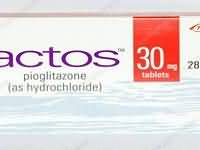CLINICAL USE
Treatment of type 2 diabetes mellitus
DOSE IN NORMAL RENAL FUNCTION
15–45 mg daily
PHARMACOKINETICS
DOSE IN RENAL IMPAIRMENT
GFR (mL/MIN)
DOSE IN PATIENTS UNDERGOING RENAL REPLACEMENT THERAPIES
IMPORTANT DRUG INTERACTIONS
Potentially hazardous interactions with other drugs
ADMINISTRATION
Reconstition
–
Route
Oral
Rate of Administration
–
Comments
–
OTHER INFORMATION
Liver function tests should be measured prior to initiation of therapy and then every 2 months for the first 12 months, and thereafter at regular intervalsPioglitazone should not be used in patients with heart failure or history of heart failure; incidence of heart failure is increased when pioglitazone is combined with insulin. Patients should be closely monitored for signs of heart failure.

